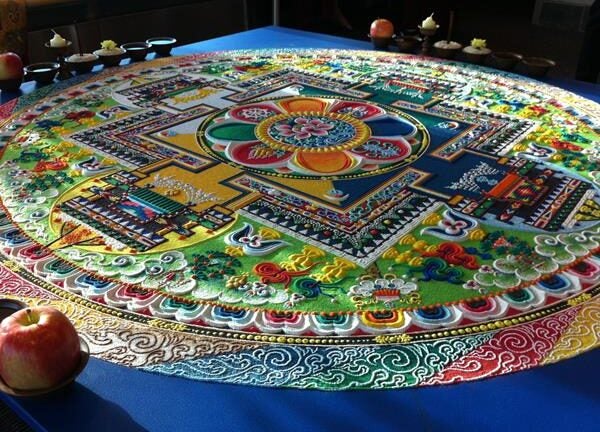
MEDIA ADVISORY: Colorful Sand Mandala Taking Shape at USC Pacific Asia Museum in Pasadena from Nov. 5-9
Contact: Carol Chaplin 626/449-2742, ext. 22 carol.chaplin@pam.usc.edu
Watch a colorful sand mandala painstakingly created by Buddhist monks from Karnataka, India, at USC Pacific Asia Museum over the next five days, culminating in a dissolution ceremony at 3:30 p.m. Sunday, Nov. 9.
The sand mandala is a traditional Tibetan Buddhist art form that involves careful placement of colored sand in an intricate design that references the world in its divine form as a path for the mind to reach enlightenment and balance.
A delegation of six monks will be creating the circular mandala in the museum’s auditorium. The project is labor-intensive, with as many as four monks at a time working on the mandala, which will be four feet in diameter. The tool they use is a bronze, funnel-like instrument called a chakpur. Using a bronze wand, they release a fine stream of sand across the grooves of the chakpur to create the designs.
At the dissolution ceremony, the monks will sweep away the mandala and distribute the sand to those in attendance.
The mandala is best appreciated as a meditative work in progress, so come by from Nov. 5 — 9 to watch it take shape.
About USC Pacific Asia Museum
USC Pacific Asia Museum is the only museum dedicated to Pacific Asia at a major research university in the United States. The museum’s mission is to further intercultural understanding through the arts of Asia and the Pacific Islands. Since 1971, USC Pacific Asia Museum has served a broad audience of students, families, adults and scholars through its education and outreach programs.
USC Pacific Asia Museum is located at 46 North Los Robles Ave., Pasadena, Calif. 91101. The museum is open Wednesday through Sunday from 10 a.m. to 6 p.m. Admission is $10 general, $7 students/seniors and free for museum members, children under 12 and USC alumni, faculty, staff and students with valid ID. Admission is free every fourth Friday of the month.



